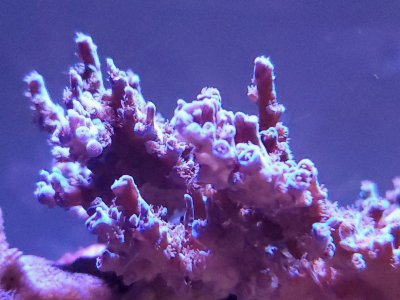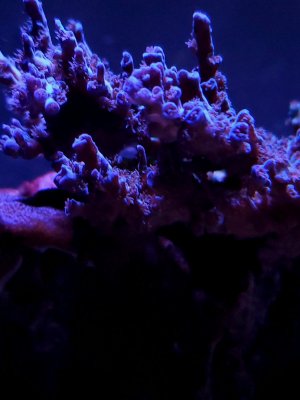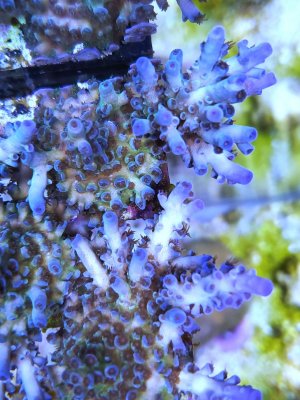It’s all your fault! Now LFS guys will be viewed as less knowledgeable, lazy bums who skipped school then got their GEDs at almost 30I did not mean for this thread to turn into a LED vs the world debate, I'm sorry if it was interpreted that way, totally not the case, I dont find these distortions bad or undesirable, on the contrary I find it very interesting, I wanted to know more about why I am seeing these distortions
From my experience, I have never seen these distortions until people started growing acropora under LED only about 8 or 9 years ago, I have noticed it much more prevalent in LED only vs hybrid systems, or T5/Halide/sunlight only.
Thank you @Dana Riddle for you contribution of knowledge.
I apologize to everyone that this started a dead horse LED debate.
Again, I'm not viewing these distortions as problematic or undesirable, I think its actually pretty neat! I was just simply asking if other stick heads noticed and if they knew possible reasons.
That is all
Navigation
Install the app
How to install the app on iOS
Follow along with the video below to see how to install our site as a web app on your home screen.
Note: This feature may not be available in some browsers.
More options
You are using an out of date browser. It may not display this or other websites correctly.
You should upgrade or use an alternative browser.
You should upgrade or use an alternative browser.
Distorted/mutant morphology in Acroporas radial and axial corallite structure.
- Thread starter C. Eymann
- Start date
- Tagged users None
When I 'eye-balled' the green LED in this luminaire, I had some concerns that it was shifted too far away from absorption spectrum of the accessory pigment peridinin. But testing with an Ocean Optics USB2000 spectrometer proved me wrong.Well I'll be darned... Dana you've proven me wrong. Apparently the spread of the emission peaks from LEDs is wider than I gave it credit for. I'll have to do some reading into why this is the case.
Why do you think the manufacturer left a gap right there at 506nm? Seems like that would be prime territory for reef light? Perhaps a materials limitation? Or is that by design?
I would attribute these growth anomalies to something along the lines of hyperplasia. There are a few kinds of I remember right and the bumpy texture I have seen in all tanks, not just led.
I tend to agree with @pedroconfuego and will go a step further to wonder if some of the examples don't have SPS bubbling issues. I've noticed that in one of my past tanks and the corallites will take on a deformed look similar to what you've shown (as well as showing bubbles). Some corals don't seem to go to bubbles but still take on that deformed look. A potential hypothesis to this could be a bacterial origin but it has not been studied that I am aware of. My tank that this occured in was lit by T5 only FWIW.
and just so people don't get upset with me and take this out of context, seeing how I responded to that blasterkid who did belittle people who work at reef shops and associated them with late age GEDs... my post got deleted for calling him out; so don't go misquoting me!It’s all your fault! Now LFS guys will be viewed as less knowledgeable, lazy bums who skipped school then got their GEDs at almost 30
I got your back bro!!! And you’re supposed to say rhymes with rickand just so people don't get upset with me and take this out of context, seeing how I responded to that blasterkid who did belittle people who work at reef shops and associated them with late age GEDs... my post got deleted for calling him out; so don't go misquoting me!
- Joined
- Jan 8, 2014
- Messages
- 15,906
- Reaction score
- 50,359
Your post was spot on!and just so people don't get upset with me and take this out of context, seeing how I responded to that blasterkid who did belittle people who work at reef shops and associated them with late age GEDs... my post got deleted for calling him out; so don't go misquoting me!
My brain can't take no more of these lighting "alien" terminologies ... yeah it's fried my brain! Well done too ... ;Dead;Mask
Joking aside pretty interesting read though
Joking aside pretty interesting read though
tick? pick? quick? mick? brick? wick? hick? sick!!!!! lick? nick?I got your back bro!!! And you’re supposed to say rhymes with rick
I don’t find it a dead horse debate.
I have long wondered why the complaint of led spectral smoothing as being a lie when you see it on nice equipment. How do they do it to have those perfectly smooth sinusoidal curves? Why do t5 and metal halide bulbs appear to be so jagged by comparison, but with a discrete floor which appears to emit trace wavelengths across from uv through IR. I don’t understand enough about how they work to explain it.
I have long wondered why the complaint of led spectral smoothing as being a lie when you see it on nice equipment. How do they do it to have those perfectly smooth sinusoidal curves? Why do t5 and metal halide bulbs appear to be so jagged by comparison, but with a discrete floor which appears to emit trace wavelengths across from uv through IR. I don’t understand enough about how they work to explain it.
I don’t find it a dead horse debate.
I have long wondered why the complaint of led spectral smoothing as being a lie when you see it on nice equipment. How do they do it to have those perfectly smooth sinusoidal curves? Why do t5 and metal halide bulbs appear to be so jagged by comparison, but with a discrete floor which appears to emit trace wavelengths across from uv through IR. I don’t understand enough about how they work to explain it.
I also don't understand why T5 bulb manufacturers don't use a greater variety of phosphors so as to produce a smoother spectral curve. Take the ATI Blue+... it's a nice smooth curve for the blue portion but then it also has those needle sharp spikes at 400nm, 440nm and 550nm. Why it is like that? Is that by design or the result of some limitation?
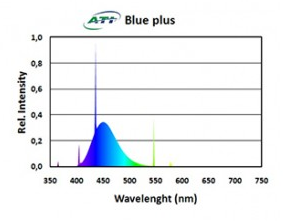
Maybe this is why there are Blue+, Coral+, Actinic, Super Actinic, Actinic White and so on. Maybe these particular bulb models allow the end user to pick and choose which wavelengths are emphasized in their particular applications.I also don't understand why T5 bulb manufacturers don't use a greater variety of phosphors so as to produce a smoother spectral curve. Take the ATI Blue+... it's a nice smooth curve for the blue portion but then it also has those needle sharp spikes at 400nm, 440nm and 550nm. Why it is like that? Is that by design or the result of some limitation?

What I have not seen is a spectrum that combines common reef lighting T5s to show how different combinations change spectral emissions intensities. That would be quite interesting!
Those spikes are line spectra of the element mercury.I also don't understand why T5 bulb manufacturers don't use a greater variety of phosphors so as to produce a smoother spectral curve. Take the ATI Blue+... it's a nice smooth curve for the blue portion but then it also has those needle sharp spikes at 400nm, 440nm and 550nm. Why it is like that? Is that by design or the result of some limitation?

That would also be the same reason metal halides have similar spikes, no? The mercury vapor is the backbone for the emission, but the overall spectral output is modified in the presence of the metal halides, no? (at least that was my rudimentary understand of how metal halide is different from plain old mercury vapor lamps)Those spikes are line spectra of the element mercury.
You are 100%, absolutely correct, Sir! Spectral characteristics of metal halide lamps = mercury vapor plus halides. Spectral characteristics of fluorescent lamps = mercury vapor plus phosphors.That would also be the same reason metal halides have similar spikes, no? The mercury vapor is the backbone for the emission, but the overall spectral output is modified in the presence of the metal halides, no? (at least that was my rudimentary understand of how metal halide is different from plain old mercury vapor lamps)
See here for comments on fluorescent lamps:

Product Review: T5 Fluorescent Lamps: UV Lighting’s ‘Super Actinic,’ ‘Actinic White,’ and ‘Aquasun’ High Output T5 Lamps
This month we'll begin an examination of T5 fluorescent lamps in general and then scrutinize several lamps manufactured by UV Lighting Company.
This as a footnote. I looked at the my zooxanthellae clade database and found in those clades found in Acropora tenuis are common in many coral genera, and there is nothing to suggest lighting would influence abnormal growths. These clades are C1 and C3 (very common) with a third C3i found only in several Acropora species. A 'D' clade - an opportunist - is often found in heat-stressed corals. I tend to think lighting is not the issue.
See here for more info:
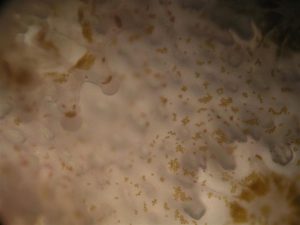
 www.advancedaquarist.com
www.advancedaquarist.com
See here for more info:

Getting Really Up to Date on Zooxanthellae (Symbiodinium spp.)
Why should anyone be interested in a rather obscure subject such as this? After all, we know that coral animals (hosts) and zooxanthellae (symbionts) generally have a mutually beneficial relationship. New information may make us re-think the symbiosis between Symbiodinium and coral animals.
What kind of numbers of corals with distortions are you talking about?I have never seen these distortions until people started growing acropora under LED only about 8 or 9 years ago, I have noticed it much more prevalent in LED only vs hybrid systems, or T5/Halide/sunlight only
Something I have noticing for a while now is the very unique/strange morphology in certain species of acropora when grown under LED only lighting, compared with corals grown under t5/led hybrid, MH and T5 only.
Example- I notice with led only grown A. tenuis that the dimidiate (lip)of the radial corallites is usually "distorted" or irregular instead of being uniform.
The axial corallites of some species almost appear to be melting/distorted like a candle stick.
Where as the same species grown under T5 hybrid or T5 only /MH doesn't show these "distortions".
Has anyone else noticed this?
I agree with this and have noticed the same thing. Often I see colonies from LEDs and they are shaped like the have been through my colon.
Similar threads
- Replies
- 5
- Views
- 245
- Replies
- 2
- Views
- 154
-
- AMS: Article
- Replies
- 2
- Views
- 801
- Replies
- 17
- Views
- 1,058
New Posts
-
Build Thread Let's See How Many SPS Coral I Can Shove in Here!
- Latest: Rocky Mountain Reef
-
-





